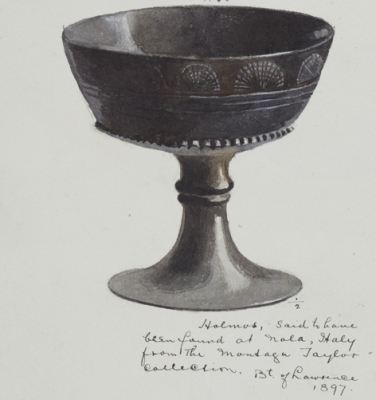To search the RPR site click here
By 1890 Pitt-Rivers was sixty-three and firmly established as a country land-owner, carrying out archaeological excavations on his own land and providing access to his collections at his private museum at Farnham, Dorset and his art gallery at King John's House, also on his estate. It seems he suffered increasingly from ill-health arising from diabetes.
His life in the 1890s
The last decade of Pitt-Rivers' life was marred by ill-health and an associated diminishment of activity. However, he continued to acquire many objects for his second collection (see below) and to carry out archaeological excavations on his estate on Cranborne Chase. At the beginning of the decade he continued to attend and hold positions in various learned societies but this diminished in the second half of the decade presumably as his health deteriorated. By 1898 he had rented his London home at 4 Grosvenor Gardens and presumably confined himself to activities on his country estate at Rushmore in Dorset.
At the start of the decade in 1890 the eldest son of his eldest son was born, he erected the 'Temple of Vesta' at Rushmore in honour of the event. This was George Pitt-Rivers, the eldest son of Pitt-Rivers' eldest son, who would inherit Pitt-Rivers' estate in 1927 from his father Alexander. However, he was not Pitt-Rivers' eldest grandchild, or even oldest grandson as Alice Fox-Pitt had produced two female children in 1885 and 1886 and a grandson in 1888 with John Lubbock. The event and celebratory temple was presumably a celebration of primogeniture.
His first collection during the 1890s
The last formal contact between Pitt-Rivers and the University of Oxford was what was, in-effect, the opening ceremony for the Pitt Rivers Museum at Oxford, his lecture at Oxford on 'The Original Collection of the Pitt-Rivers [sic] Museum: its principles of arrangement and history' on 30 April 1890.
By the 1890s the connections between Pitt-Rivers (the man) and his eponymous museum in Oxford had been weakened. Although correspondence between Pitt-Rivers, Henry Balfour (the first full-time Curator of the Museum) and Edward Burnett Tylor (the Keeper of the Oxford University Museum and Professor of Anthropology at Oxford) continued throughout the decade there was very little day-to-day contact or consultation.
His second collection during the 1890s
He acquired over 9,000 objects for his second collection in this decade. This is only a little less than he acquired during the 1880s so it is clear that his interest in acquiring new objects for his collection had not diminished. The vast majority of these were obtained from dealers and auctioneers. One of the reasons why objects from these sources are even more dominant than in the 1880s is that he seems not to have travelled abroad during the 1890s (presumably again because of his health). This diminished his opportunities to collect artefacts from himself as he had done during his summer holidays in France, Austria-Hungary, Germany and Switzerland before.
His publication during the 1890s
There were noticeably less publications published by Pitt-Rivers during the 1890s compared to his output in previous decades since 1860.
Pitt-Rivers, A.H.L.F. 1890 King John's House, Tollard Royal, Wilts. Printed privately
Pitt-Rivers, A.H.L.F. 1891 'Typological Museums, as exemplified by the Pitt Rivers Museum in Oxford and his provincial museum in Farnham, Dorset' Journal of the Society of Arts 40 [1891] pp. 115-122
Pitt-Rivers, A.H.L.F. 1892 Excavations in Bokerley Dyke and Wansdyke Dorset and Wilts 1888-91 vol III of Cranborne Chase Rushmore privately printed
Pitt-Rivers, A.H.L.F. 1898 Excavations in Cranborne Chase. vol IV Rushmore Privately printed
1900
Pitt-Rivers died in May 1900 and was cremated in Woking with his funeral being held on 10 May 1900 at Tollard Royal. Antique Works of Art from Benin was published in the year of his death. Six years after his death an edited volume of his major publications edited by John Linton Myres was published.
Pitt-Rivers, A.H.L.F. 1900. Antique Works of Art from Benin Collected by Lieutenant-General Pitt Rivers, no place: privately published.
Pitt-Rivers, A.H.L.F. 1906 [ed. JL Myers, intro by Henry Balfour] The Evolution of Culture and other essays Clarendon Press Oxford UK
AP, May 2011




